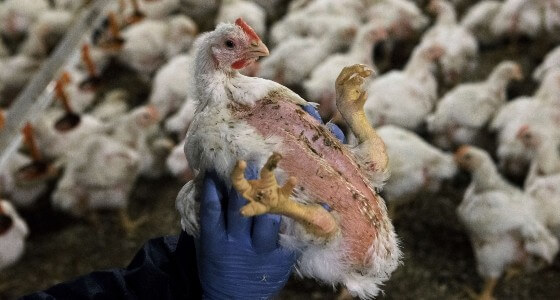China is seeing a surge in respiratory illnesses which has raised alarms both domestically and internationally. Among the viruses contributing to this uptick is the human metapneumovirus or HMPV, leading to concerns about its potential to escalate into a global health crisis.
So what is the current situation in China, are the hospitals overwhelmed due to the surge in HMPV cases and what is the likelihood of it becoming another pandemic?
Current Situation in China
Recent reports indicate a significant increase in respiratory infections across China, particularly affecting children under 14 in the northern provinces.
Hospitals are reportedly overwhelmed, with social media platforms flooded with videos and accounts of crowded medical facilities. Multiple viruses, including HMPV, influenza A, Mycoplasma pneumoniae, and even COVID-19, are purportedly circulating simultaneously, aggravating the strain on the healthcare system.
Understanding Human Metapneumovirus (HMPV)
HMPV is a respiratory virus first identified in 2001. It is known to cause both upper and lower respiratory tract infections, ranging from mild cold-like symptoms to severe bronchiolitis and pneumonia.
The virus is particularly concerning for young children, the elderly, and individuals with compromised immune systems.
Symptoms typically include cough, fever, nasal congestion, and shortness of breath. Transmission occurs through respiratory droplets when an infected person coughs or sneezes, and by touching surfaces contaminated with the virus.

Is HMPV Another Pandemic in the Making?
While the surge in HMPV cases in China is concerning, several factors suggest that it is unlikely to develop into a pandemic akin to COVID-19, for now –
1) Transmission Dynamics: HMPV spreads through close contact and respiratory droplets, similar to other common respiratory viruses. Unlike highly contagious viruses such as measles or SARS-CoV-2, HMPV has not demonstrated the same level of rapid, widespread transmission.
2) Severity and Mortality Rates: Although HMPV can cause severe illness in vulnerable populations, the overall mortality rate is significantly lower compared to viruses like H5N1 avian influenza or SARS-CoV-2. Most HMPV infections result in mild to moderate illness, with severe outcomes primarily in high-risk groups.
3) Historical Prevalence: HMPV is not a new virus; it has been circulating globally since its identification. Seasonal outbreaks occur, particularly in late winter and early spring, but have not previously led to global pandemics.
4) Current Containment Measures: Chinese health authorities have intensified screening, detection, and isolation protocols to manage the outbreak. Public health measures, including promoting hand hygiene, mask-wearing, and social distancing, are being reinforced to curb the spread.
Comparisons with Other Viruses
It’s important to distinguish HMPV from other viruses currently causing concern. For instance, the H5N1 avian influenza virus has been noted for its potential to cause a pandemic due to its high mortality rate and recent mutations that may facilitate human-to-human transmission. However, HMPV does not share the same characteristics that make H5N1 a significant pandemic threat.
Preventive Measures and Recommendations
To mitigate the spread of HMPV and other respiratory viruses, the following measures are recommended:
Hand Hygiene: Regular and thorough handwashing with soap and water.
Respiratory Etiquette: Covering mouth and nose with a tissue or elbow when coughing or sneezing.
Avoiding Close Contact: Maintaining distance from individuals exhibiting symptoms of respiratory illness.
Surface Disinfection: Regular cleaning of frequently touched surfaces.
Staying Informed: Keeping abreast of public health advisories and adhering to guidelines issued by health authorities.

The UK’s Bird Flu Crisis. A New Threat In The Making?
Meanwhile, United Kingdom is seeing an outbreak of Bird Flu or Avian Influenza.
Bird flu refers to infections caused by avian influenza viruses, primarily H5N1 and H5N6. These viruses predominantly affect birds but can occasionally infect humans, often through direct contact with infected birds or their droppings.
Current Outbreak in the UK
The UK has declared multiple outbreaks of highly pathogenic avian influenza (HPAI), particularly H5N1, across its poultry and wild bird populations. Over 200 cases were confirmed in 2024 alone, and over the festive period, with 15 cases of the H5N1 strain confirmed since the start of the bird flu “season”, and one case of the H5N5 strain.
Regional restriction zones were put into place on 23 December across East Riding of Yorkshire, Kingston upon Hull, Lincolnshire, Norfolk and Suffolk.
On 24 December, H5N1 was confirmed in commercial poultry at a third premises near Attleborough, Breckland, Norfolk.
A further premises near Beverley, East Riding of Yorkshire, was then confirmed with the disease on 28 December.
On 31 December, a confirmed case was found in commercial poultry at a premises housing 32,000 broiler breeders near Nafferton, East Riding of Yorkshire.
Under current rulings, all poultry on premises with confirmed cases are humanely culled and a 3km protection zone and 10km surveillance zone are put into place.
Why Is This Outbreak Concerning?
1) Mutations: Recent studies indicate that the H5N1 virus may have undergone mutations enabling limited mammalian transmission. This development raises alarms about the virus’s pandemic potential.
2) High Mortality: In humans, H5N1 infections have a mortality rate exceeding 50%, far higher than most respiratory viruses.
3) Economic Impact: The outbreak has led to mass culling of birds, significantly affecting poultry farmers and disrupting the food supply chain.
Is H5N1 a Pandemic Threat?
While the virus remains primarily zoonotic, experts caution that it is “one mutation away” from becoming transmissible between humans. Such a mutation could result in a public health emergency similar to, or even worse than, COVID-19.
Lessons from Past Pandemics and China’s Role in Global Health Crises
China has often been the epicenter of global health crises, including SARS in 2002-2003 and COVID-19 in 2019. The current situation signifies the importance of early detection, transparency, and international collaboration to mitigate potential outbreaks.
The COVID-19 pandemic exposed significant gaps in global healthcare systems, from testing capabilities to vaccine distribution.
Preventive Measures For Bird Flu
–Avoid contact with birds and poultry in outbreak zones.
–Cook poultry and eggs thoroughly.
–Follow government advisories on culling and containment.
The Last Bit – A Tense Start to 2025
While neither HMPV in China nor the bird flu in the UK has reached pandemic proportions, both firmly illustrate the fragile equilibrium of global health.
The world, still recovering from COVID-19, cannot afford to be complacent. Instead, it must strengthen its defenses against the ever-present risk of emerging infectious diseases.
In today’s interconnected world, the health of one nation affects us all.















